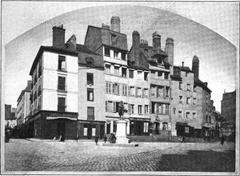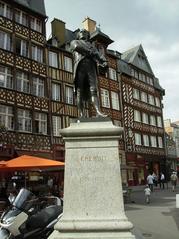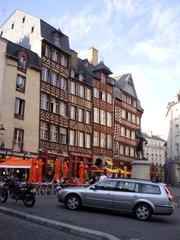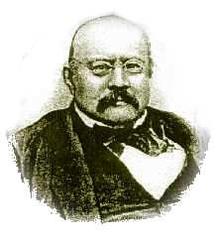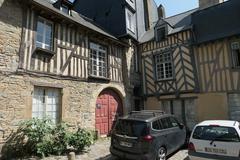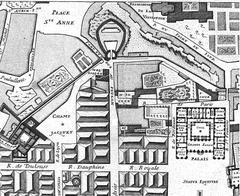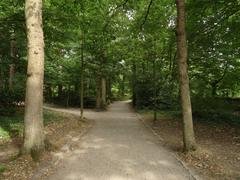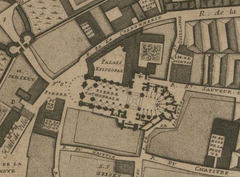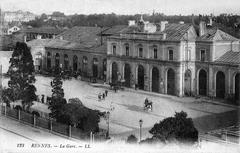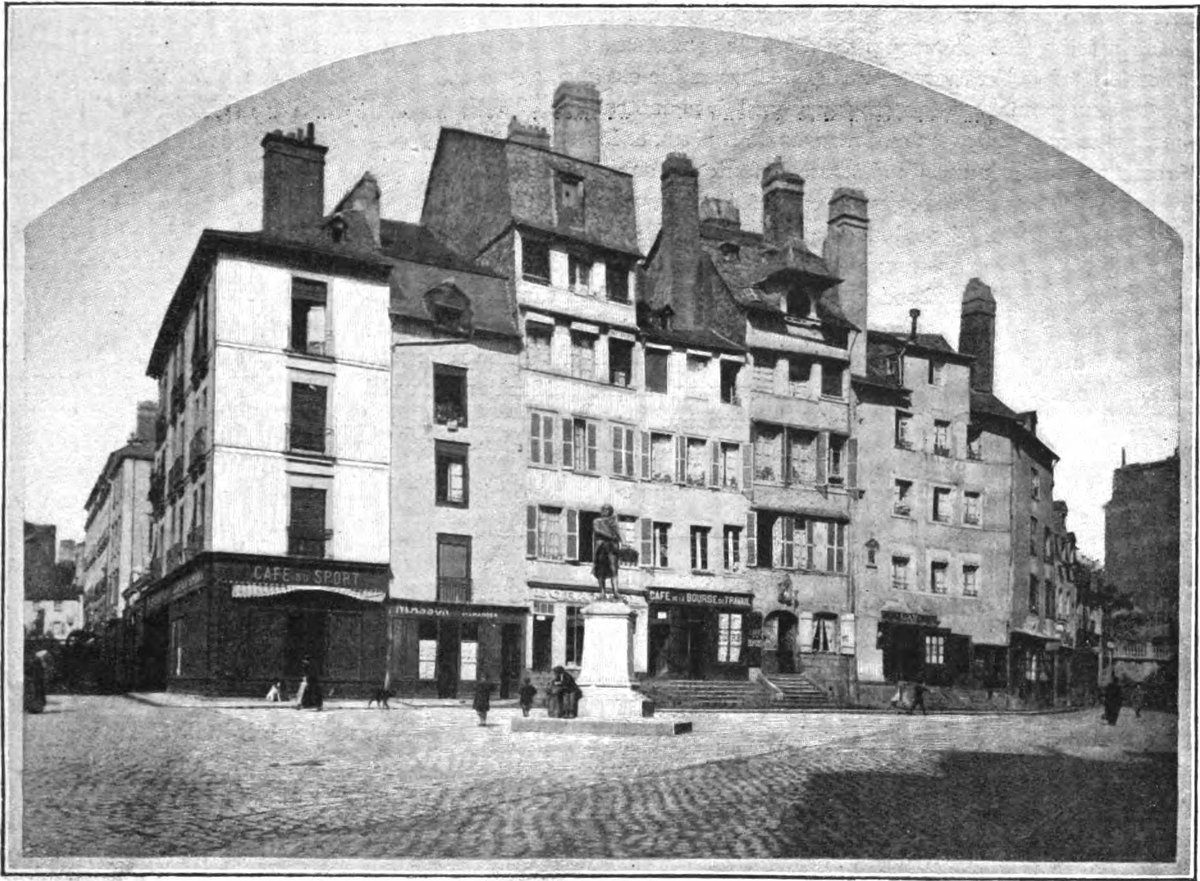
Jean Leperdit Visiting Hours, Tickets, and Rennes Historical Sites Guide
Date: 14/06/2025
Introduction
Nestled in the heart of Rennes, France, the Jean Leperdit statue is a powerful tribute to one of the city’s most courageous revolutionary figures. Jean Leperdit (1761–1829) was a tailor who became mayor during the French Revolution and is celebrated for his principled resistance to the Reign of Terror—most famously by tearing up lists of condemned citizens, saving many from execution. His legacy endures as a symbol of justice, resistance to tyranny, and civic virtue in Rennes’ identity.
This guide provides comprehensive information for visiting the Jean Leperdit statue and exploring related historical sites in Rennes. You’ll find practical details on visiting hours, ticketing, accessibility, and guided tours, as well as background on Leperdit’s historical significance, the statue’s artistic features, nearby attractions, and travel tips. Whether you’re a history enthusiast or a curious traveler, this guide will help you make the most of your journey through Rennes’ revolutionary heritage.
For more details, consult official tourism and cultural resources: Rennes Tourist Office, Musée de Bretagne, Jean Leperdit Statue on Monumentum.
Who Was Jean Leperdit? Historical Background
Jean Leperdit was born in Rennes and became a respected master tailor before entering public service. Elected as mayor in 1790, Leperdit gained renown for his moral courage during the darkest days of the French Revolution. In 1793, he refused to sign—and famously tore up—a list of 300 names destined for execution, risking his own safety to save others. This act has made him an enduring symbol of justice and civic responsibility in Rennes (Ville de Rennes).
The Jean Leperdit Statue: Artistic Features and Location
Created by sculptor Jean Boucher in 1911, the bronze statue of Jean Leperdit captures him in the act of tearing the execution list—a direct reference to his famous act of resistance. The monument stands on a stone pedestal in a dynamic, expressive pose, exemplifying early 20th-century French civic sculpture (Base Joconde). Its location in Place Jean Leperdit, near the Hôtel de Ville (City Hall), highlights Leperdit’s enduring connection to Rennes’ civic life.
Visual Recommendation: Include an image of the statue with alt text: “Statue of Jean Leperdit in Rennes, holding a torn list.”
Visiting the Jean Leperdit Statue: Hours, Tickets, and Accessibility
Location and Getting There
- Address: Place Jean Leperdit, 35000 Rennes, France
- Access: Centrally located, within walking distance of main city attractions.
- Public Transport:
- Metro: Line A to République station
- Bus: Multiple lines stop at Place de la République
- Bike/Foot: Rennes is pedestrian and cyclist-friendly
Visiting Hours
- Statue: Outdoors and accessible 24/7, year-round.
- Nearby Museums:
- Musée de Bretagne: Tuesday to Sunday, 10:00 AM – 6:00 PM; closed Mondays
- Rennes Tourist Office: Monday to Saturday, 9:00 AM – 6:00 PM
Ticketing and Entry Fees
- Statue: Free to visit, no tickets required.
- Museums/Exhibitions: Check individual websites for current ticket prices.
Accessibility
- Statue Area: Wheelchair accessible with smooth pavements and ramps.
- Museums/Public Spaces: Most provide accessibility services, including ramps and elevators.
- Amenities: Benches and public toilets available nearby.
Guided Tours and Visitor Tips
- Guided Tours: The Rennes Tourist Office offers walking tours focused on the city’s revolutionary history, including the Jean Leperdit statue. Advance booking is recommended, especially in high season (Rennes Tourist Office).
- Best Time to Visit: Spring and early autumn offer mild weather and fewer crowds. Early morning or late afternoon provides optimal lighting for photography.
- Photography: Permitted and encouraged. The statue and surrounding historic squares make for excellent photo opportunities.
- Etiquette: Please respect the monument, refrain from climbing, and observe moments of silence during commemorative events.
Nearby Historical and Cultural Attractions
- Musée de Bretagne: Exhibits on the region’s history and culture (Musée de Bretagne).
- Parlement de Bretagne: Historic parliament building offering guided tours.
- Place du Champ-Jacquet: Picturesque square with half-timbered houses and vibrant atmosphere.
- Place des Lices: Hosts one of France’s largest markets every Saturday.
- Parc du Thabor: Landscaped gardens and green spaces for relaxation.
Suggested Itinerary
- Start at the Jean Leperdit statue in Place Jean Leperdit.
- Walk to Place du Champ-Jacquet to admire the unique 17th-century timber-framed houses.
- Visit the Parlement de Bretagne for a guided tour of its historic interiors.
- End your stroll at Parc du Thabor or enjoy refreshments at a café in Place des Lices.
Maison Leperdit: Exploring the Mayor’s Home
- Location: 19 Place Sainte-Anne
- Visiting Hours: Tuesday to Sunday, 10:00 AM – 6:00 PM
- Admission: Adults €5; children under 12 free
- Guided Tours: Wednesdays and Saturdays at 11:00 AM and 3:00 PM (advance booking recommended)
- Accessibility: Partial wheelchair access; inquire ahead for assistance (Maison Leperdit Visitor Information)
Maison Leperdit is a well-preserved example of Rennes’ urban architecture from the revolutionary era and offers further insights into Leperdit’s life and the city’s transformation.
Cultural Context and Local Traditions
Rennes is celebrated for its revolutionary past and strong regional identity. The Jean Leperdit statue is integrated into school programs and local heritage events, serving as both a meeting point and a site for commemorations, especially on Bastille Day and during the Fête de la Bretagne. The square is often adorned with flowers or banners, reflecting its living role in civic life (Ville de Rennes).
Frequently Asked Questions (FAQ)
Q: What are the visiting hours for the Jean Leperdit statue?
A: The statue is accessible 24/7, year-round.
Q: Is there an entrance fee?
A: No, visiting the statue is free.
Q: Are guided tours available?
A: Yes, guided walking tours are available through the Rennes Tourist Office.
Q: Is the site wheelchair accessible?
A: Yes, the statue and most central squares are wheelchair accessible.
Q: What is the best time to visit?
A: Spring or early autumn for mild weather, early morning or late afternoon for quiet and good light.
Q: Are there special events at the statue?
A: Commemorations and cultural events are occasionally held at the square—check the local events calendar.
Practical Travel Tips
- Rennes Citypass: Offers discounts for museums and tours; available online or at the tourist office.
- Transportation: Rennes is two hours from Paris by TGV; the city center is compact and walkable.
- Accommodation: Book early in peak season.
- Local Specialties: Sample Breton galettes and cider in cafés near Place du Champ-Jacquet.
Sources and Further Reading
- Rennes Tourist Office
- Musée de Bretagne
- Jean Leperdit Statue on Monumentum
- Base Joconde
- Maison Leperdit Visitor Information
- Rennes Heritage
- Météo France
Plan Your Revolutionary Visit
The Jean Leperdit statue stands not only as an artistic and historical landmark but also as a powerful symbol of justice and civic courage. With its central location, free access, and proximity to Rennes’ most fascinating sites, it is an essential stop for anyone seeking to understand the city’s revolutionary heritage.
Ready to discover Rennes?
Download the Audiala App for self-guided tours, interactive maps, and the latest visitor information. Follow Rennes tourism for updates on events and special offers.
Images and maps are recommended to enhance your visit. Alt text ensures accessibility for all.
